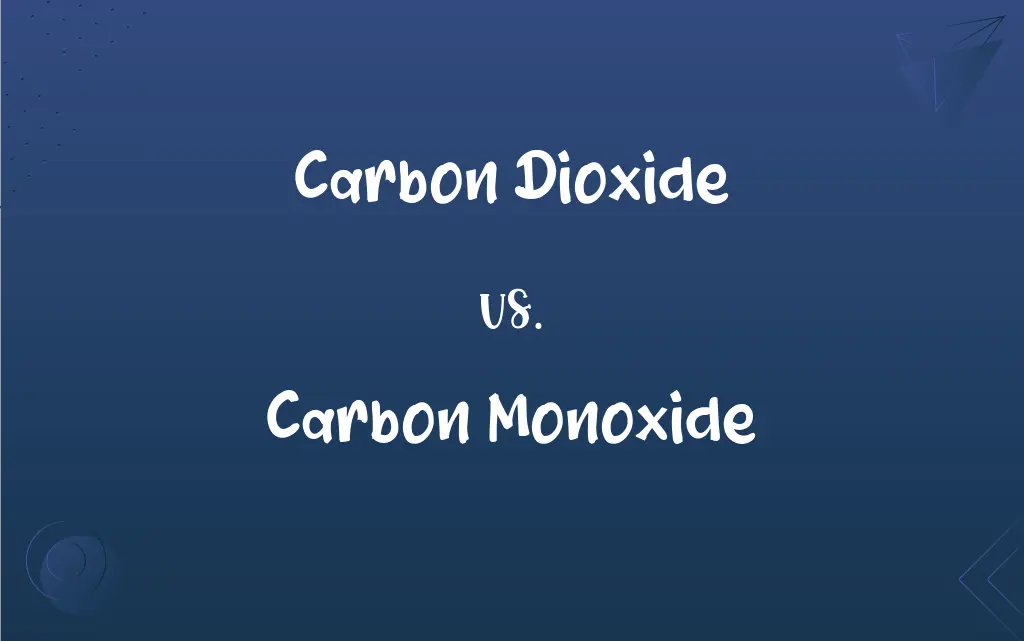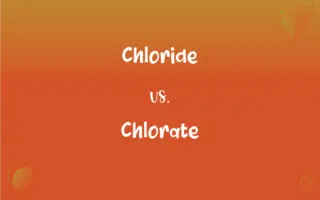Carbon Dioxide vs. Carbon Monoxide: What's the Difference?
Edited by Aimie Carlson || By Harlon Moss || Updated on October 23, 2023
Carbon dioxide (CO₂) is a colorless gas vital for photosynthesis, while carbon monoxide (CO) is a toxic gas resulting from incomplete combustion.

Key Differences
Carbon dioxide (CO₂) and carbon monoxide (CO) are both gaseous compounds containing carbon and oxygen. However, carbon dioxide has two oxygen atoms bonded to a carbon atom, whereas carbon monoxide consists of one carbon atom bonded to one oxygen atom.
Carbon dioxide plays an essential role in the Earth's ecosystem. It's produced during the respiration process of animals and humans and is absorbed by plants during photosynthesis. On the contrary, carbon monoxide does not have a significant role in natural biological processes and is primarily known for its toxic properties.
The sources of carbon dioxide and carbon monoxide vary. Carbon dioxide is commonly produced during the complete combustion of carbon-containing fuels, whereas carbon monoxide is formed during incomplete combustion. This means when there isn't enough oxygen to produce carbon dioxide, carbon monoxide is generated.
From a health perspective, carbon dioxide is generally harmless in low concentrations but can be asphyxiating in high concentrations. Carbon monoxide, however, is toxic, even in small amounts, as it binds with hemoglobin in the blood, preventing oxygen from being effectively transported to body tissues.
Commercially and industrially, carbon dioxide finds uses in various applications, from beverage carbonation to fire extinguishers. Carbon monoxide, due to its reactive nature, is utilized in many industrial processes, including the production of various chemicals.
ADVERTISEMENT
Comparison Chart
Molecular Formula
CO₂
CO
Oxygen Atoms per Molecule
Two
One
Biological Role
Vital for photosynthesis
Toxic, no significant natural role
Formation
Complete combustion
Incomplete combustion
Health Implications
Asphyxiating at high concentrations
Toxic, binds with hemoglobin
ADVERTISEMENT
Carbon Dioxide and Carbon Monoxide Definitions
Carbon Dioxide
Carbon dioxide is a colorless, odorless gas consisting of one carbon and two oxygen atoms.
Plants absorb carbon dioxide during the photosynthesis process.
Carbon Monoxide
It is used in various industrial processes as a reducing agent.
Carbon monoxide is involved in producing some types of steel.
Carbon Dioxide
It's a byproduct of animal respiration and combustion processes.
Every time we exhale, we release carbon dioxide into the atmosphere.
Carbon Monoxide
It's produced mainly through the incomplete combustion of carbon-containing materials.
Poorly ventilated fireplaces can produce carbon monoxide.
Carbon Dioxide
Carbon dioxide is an essential greenhouse gas in Earth's atmosphere.
Increased levels of carbon dioxide contribute to global warming.
Carbon Monoxide
Carbon monoxide can interfere with the blood's ability to carry oxygen.
Prolonged exposure to carbon monoxide can be fatal due to oxygen deprivation.
Carbon Dioxide
It's used in various industries, including food and medicine.
Carbonated beverages contain dissolved carbon dioxide to give them fizz.
Carbon Monoxide
Carbon monoxide is a colorless, odorless, and toxic gas with a molecule consisting of one carbon and one oxygen atom.
Faulty heaters can emit dangerous levels of carbon monoxide.
Carbon Dioxide
Carbon dioxide acts as a solvent in supercritical form.
Supercritical carbon dioxide is used in decaffeinating coffee beans.
Carbon Monoxide
Carbon monoxide alarms are devices designed to detect CO presence.
Installing a carbon monoxide alarm can prevent CO poisoning incidents.
FAQs
How does carbon monoxide affect human health?
Carbon monoxide binds to hemoglobin in blood, inhibiting its ability to transport oxygen.
What is the primary source of carbon dioxide in the atmosphere?
The primary source of carbon dioxide is the combustion of fossil fuels.
Is carbon dioxide a greenhouse gas?
Yes, carbon dioxide is a major greenhouse gas contributing to global warming.
Can carbon monoxide be detected by smell or sight?
No, carbon monoxide is colorless and odorless, making it hard to detect without instruments.
Why is carbon monoxide termed a "silent killer"?
Carbon monoxide is called a "silent killer" because it's odorless, colorless, and can be lethal.
What are common sources of carbon monoxide in homes?
Common sources include faulty gas appliances, heaters, and unvented fireplaces.
How can one protect themselves from carbon monoxide poisoning?
Installing carbon monoxide detectors and ensuring proper ventilation can help prevent poisoning.
Is carbon dioxide heavier than air?
Yes, carbon dioxide is denser than air.
Why is carbon monoxide used in the production of steel?
Carbon monoxide acts as a reducing agent, removing oxygen from iron ore.
What is the role of carbon dioxide in the carbon cycle?
Carbon dioxide is taken in by plants for photosynthesis and released by animals during respiration, maintaining a balance.
How can we reduce carbon dioxide emissions?
By using renewable energy sources, increasing energy efficiency, and planting trees.
How does carbon dioxide affect ocean acidity?
Carbon dioxide dissolves in seawater, forming carbonic acid which increases ocean acidity.
How do plants use carbon dioxide?
Plants use carbon dioxide during photosynthesis to produce glucose.
Are there industrial uses for carbon monoxide?
Yes, carbon monoxide is used in processes like methanol production and the Fischer-Tropsch process.
How quickly can carbon monoxide cause harm?
Carbon monoxide can cause harm within minutes, depending on its concentration.
How is carbon dioxide concentration measured in the atmosphere?
Carbon dioxide concentration is typically measured in parts per million (ppm) using instruments like infrared gas analyzers.
Is there a treatment for carbon monoxide poisoning?
Yes, immediate medical attention and oxygen therapy can treat carbon monoxide poisoning.
Can carbon dioxide be used in fire extinguishers?
Yes, carbon dioxide is used in certain fire extinguishers to displace oxygen.
What are the symptoms of carbon monoxide poisoning?
Symptoms include headache, dizziness, weakness, nausea, and confusion.
Can carbon dioxide be converted back into oxygen?
Through photosynthesis, plants convert carbon dioxide into oxygen and glucose.
About Author
Written by
Harlon MossHarlon is a seasoned quality moderator and accomplished content writer for Difference Wiki. An alumnus of the prestigious University of California, he earned his degree in Computer Science. Leveraging his academic background, Harlon brings a meticulous and informed perspective to his work, ensuring content accuracy and excellence.
Edited by
Aimie CarlsonAimie Carlson, holding a master's degree in English literature, is a fervent English language enthusiast. She lends her writing talents to Difference Wiki, a prominent website that specializes in comparisons, offering readers insightful analyses that both captivate and inform.































































